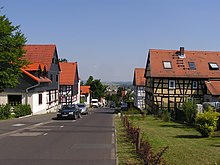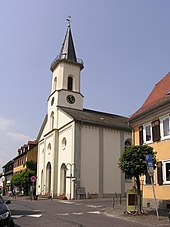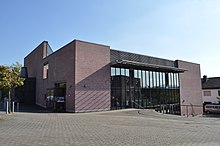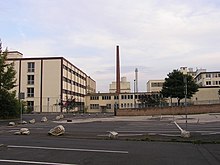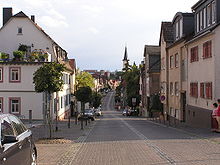Friedrichsdorf
| coat of arms | Germany map | |
|---|---|---|

|
Coordinates: 50 ° 15 ' N , 8 ° 39' E |
|
| Basic data | ||
| State : | Hesse | |
| Administrative region : | Darmstadt | |
| County : | Hochtaunuskreis | |
| Height : | 199 m above sea level NHN | |
| Area : | 30.16 km 2 | |
| Residents: | 25,234 (Dec. 31, 2019) | |
| Population density : | 837 inhabitants per km 2 | |
| Postal code : | 61381 | |
| Primaries : | 06172 (Friedrichsdorf, Dillingen, Seulberg ), 06175 ( Köppern ), 06007 ( Burgholzhausen ) |
|
| License plate : | HG, USI | |
| Community key : | 06 4 34 002 | |
| LOCODE : | DE FRF | |
| City structure: | 4 districts | |
City administration address : |
Hugenottenstrasse 55 61381 Friedrichsdorf |
|
| Website : | ||
| Mayor : | Horst Burghardt ( Greens ) | |
| Location of the city of Friedrichsdorf in the Hochtaunus district | ||
Friedrichsdorf is the third largest city in the Hessian Hochtaunuskreis and part of the Frankfurt metropolitan area , the largest agglomeration in the Rhine-Main area
geography
Geographical location
Friedrichsdorf is located on the southern slope of the Taunushauptkamm and is the third largest city in the Hochtaunuskreis after Bad Homburg and Oberursel . The urban area includes on the one hand agricultural areas such as Burgholzhausen , which form the transition to the Wetterau . On the other hand, there is a large contiguous forest area on the Taunus ridge. There is the highest point of the district, the mountain Gickelsburg , at 471 m above sea level. NN . The Erlenbach flows through the city from the Taunus ridge .
climate
The city's location on the southern slope of the Taunushauptkamm means a higher number of hours of sunshine, and the city is also protected from cold north winds.
|
Average monthly temperatures and precipitation for Friedrichsdorf
Source: Temperature: MSN Weather , Precipitation: DWD (free weather data) Bad Homburg-Gonzenheim station
|
||||||||||||||||||||||||||||||||||||||||||||||||||||||||||||||||||||||||||||||||||||||||||||||||||||||||||||||||||||||||||||||||||||||||||||||||||||||
Neighboring communities
Friedrichsdorf borders the city of Rosbach ( Wetteraukreis ) to the north and east , the city of Bad Homburg to the south and the municipality of Wehrheim (both Hochtaunuskreis) to the west .
City structure
Friedrichsdorf is made up of the core city around Hugenottenstraße with a smooth transition to the Dillingen district and the other districts. The Köppern district is north of the city center. Burgholzhausen is the only part of Friedrichsdorf east of the A5 . Seulberg is located south of the city center; the settlement also goes over seamlessly. The Römerhof and Schäferborn settlements belonging to Seulberg, east of the railway lines and southeast of the city center, are directly adjacent to the settlement.
In 1916 Dillingen was incorporated. In the course of the regional reform in Hesse , on August 1, 1972, the city of Friedrichsdorf and the previously independent communities of Köppern, Burgholzhausen vor der Höhe from the district of Friedberg and Seulberg were merged by state law to form today's city of Friedrichsdorf in the Obertaunus district .
For the districts of Burgholzhausen vor der Höhe , Friedrichsdorf, Köppern and Seulberg and local districts were established.
Burgholzhausen
1221 is in charters mentioned Burgholzhausen as Holzhausen first time. In 1803 Burgholzhausen was one of the last five remaining free imperial villages in the Old Kingdom . In addition to agriculture and linen weaving, the most important branches of business were the manufacture of tiles , the raw material of which was obtained from nearby clay pits. At the end of the 17th century, fruit growing in Burgholzhausen was intensified by the rule of the Ingelheim family .
Dillingen
The former town of Tulingen was first mentioned in a document in 1192 or 1229, but fell desolate during the Thirty Years' War . An attempt to resettle with Huguenots by order of Landgrave Friedrich II of Hessen-Homburg in 1687 failed, and the Huguenots soon moved to the newly founded Friedrichsdorf. Dillingen was re-founded in 1804 by Landgrave Friedrich V of Hessen-Homburg , the name being given to the old town. In 1916 the place was incorporated into Friedrichsdorf.
Bodies
Köppern is first mentioned in a document in 1269. At this time, the Burchard von Printsac was given a mill to coppers by Count Gerhard von Eppstein as a fief . For a long time, linen weaving and brick making were the most important branches of business alongside agriculture. Later, the manufacture of hats and the processing of leather were added. In 1901, the Frankfurt doctor Emil Sioli founded the forest hospital (specialist clinic for psychiatry and psychotherapy ) that still exists today .
Seulberg
In Lorsch Codex Seulberg is 767 mentioned for the first time. Seulberg is one of the oldest settlements in the Hochtaunus district. Finds of the Rössen culture indicate a settlement in the Neolithic Age. In addition to agriculture and linen weaving, pottery has long been an important line of business here. There were lively trade relations with the Huguenots in Friedrichsdorf. Seulberg was not spared from the persecution of witches, which killed 26 women and 6 men between 1652 and 1656.
history
Traces of settlement in the urban area of Friedrichsdorf by a brickworks have been documented as early as Roman times .
The foundation in 1687 goes back to the persecution of Huguenots in France . Around 200,000 of the 800,000 Protestants living in France at the time fled their homeland. Landgrave Friedrich II allegedly invited her to settle in the Landgraviate of Hesse-Homburg with the words “I would rather sell my silver equipment than refuse these poor people” . The Huguenots founded Friedrichsdorf, which they named after him out of gratitude. They brought with them knowledge of the textile trade and thus laid the foundation for rapid economic growth, which was intended by Friedrich II. At first they made linen and fine linen, from the middle of the 18th century stockings and finally flannel . The economic prosperity was recognized in 1771 when it was granted city rights. In the former main road after a short name change during the Nazi state in Hugenottenstraße was renamed recalls opposite the church a stone pillar at the ceremony. In 1873, a cast iron bust of Landgrave Friedrich was made and placed on a former Nassau border column made of Lahn marble at the Schnepfenburg (the Landgrave column ), then moved to Landgrafenplatz in the city center, named after him, in 1937.
Today's Dillingen was only founded in 1804, with the permission of Friedrich V. Vogelsberger farmers settled here in the previously wooded area north of a desert . The old Dillingen - in 1192 a Friedrich von Dillingen attested the contract with which Gottfried von Eppstein bought castle rights , in 1229 the village Tulingen was first mentioned - was with the place Willkommshausen and a moth , whose wall remnants east of the place on the old border road as Schnepfenburg are known to have been depopulated in the Thirty Years War . Between today's Dillingen and Friedrichsdorf, the Brendelburg is believed to be on the grounds of the Garnier Institute .
When textile production was no longer competitive with industrial production in England, the dyeing of textiles dominated, especially blue dyeing (with vegetable substances, alcohol and human urine). Four of the formerly very numerous dye houses are still preserved today. Leather was produced for a short time, a hat production (the Homburger ) took place on a noteworthy scale, for example in the Köpperner hat factory.
Later (the rusk factory Ferd. Stemler was founded in 1788) the production of rusks was added in Friedrichsdorf , which differed very advantageously from other extremely resistant (hard) products at the time. The Friedrichsdorfer were so successful with this that their town was given the nickname " City of Rusks ". The Milupa company emerged from the rusk manufacturer Emil Pauly and expanded to a large area in the city center.
One of the city's most famous citizens was Philipp Reis , a physics teacher at the Garnier Institute and inventor of the electrical transmission of speech, better known as the telephone .
The long-lasting French language of the Huguenots, which mixed with the Hessian dialect, was characteristic of Friedrichsdorf. Friedrich Stoltze summarized the mixture of languages in a poem :
“Hélas, Martin! Hélas, Martin!
Chassez le Gickel from the jardin!
Il scratched mer, häst tu le Steuwe!
Toutes les nouveaux go to Reuwe! "
Alexandre Dumas the Elder described Friedrichsdorf in one of his travel reports in 1838 as "a whole Protestant village with idioms that can only be found in Molière" . Until the First World War, French was the primary language in Friedrichsdorf. Services in the Reformed Church were also held in French until 1913.
politics
City Council
The city council is the highest body of the city. Its political composition is determined every five years in local elections by the city's electorate. Whoever has reached the age of 18 and is a German citizen within the meaning of the Basic Law or a citizen of one of the other member states of the European Union may vote. Everyone has to have been registered in the city for at least three months.
The local elections on March 6, 2016 produced the following results, compared to previous local elections:
| Parties and constituencies | % 2016 |
Seats 2016 |
% 2011 |
Seats 2011 |
% 2006 |
Seats 2006 |
% 2001 1 |
Seats 2001 |
% 1997 |
Seats 1997 |
|
|---|---|---|---|---|---|---|---|---|---|---|---|
| FWG | Free voters | 25.7 | 10 | 17.4 | 6th | 15.5 | 6th | 8.5 | 3 | 9.4 | 4th |
| CDU | Christian Democratic Union of Germany | 23.9 | 9 | 31.7 | 12 | 37.1 | 14th | 34.1 | 13 | 26.8 | 11 |
| Green | Alliance 90 / The Greens | 21.9 | 8th | 25.5 | 9 | 15.9 | 6th | 14.5 | 5 | 16.7 | 7th |
| SPD | Social Democratic Party of Germany | 13.4 | 5 | 18.4 | 7th | 19.9 | 7th | 26.4 | 10 | 21.9 | 9 |
| FDP | Free Democratic Party | 11.6 | 4th | 7.0 | 3 | 8.6 | 3 | 6.3 | 2 | 4.9 | |
| left | The left | 3.4 | 1 | - | - | - | - | - | - | - | - |
| REP | The Republicans | - | - | - | - | 1.9 | 1 | 2.3 | 1 | 4.7 | |
| LLF | Left list Friedrichsdorf | - | - | - | - | 1.1 | - | - | - | - | |
| UWG | Independent voter community | - | - | - | - | - | - | 8.0 | 3 | 15.6 | 6th |
| total | 100.0 | 37 | 100.0 | 37 | 100.0 | 37 | 100.0 | 37 | 100.0 | 37 | |
| Turnout in percent | 50.5 | 49.5 | |||||||||
37 city councilors and the city's local councils had to be elected for the legislative period from April 1, 2016 to March 31, 2021. Of the 19,421 eligible voters, 9,810 voted. As a result, voter turnout rose from 49.5% in 2011 to 50.5% in 2016.
mayor
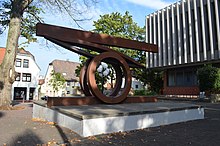
- Abraham Rousselet
- Otto Foucar , 1918
- Walter Ziess (UWG), 1954–1972
- Wilfried Fey (SPD), 1972–1978
- Gerd Schmidt (FWG), 1985-1997
- Horst Burghardt (Greens), since 1997
coat of arms

Historical coat of arms
Blazon : "In blue, nine wreath-shaped silver roses with golden lugs and green sepals."
The village, which was established in 1687 as a settlement for French refugees (Huguenots) and was named after its founder, Landgrave Friedrich II of Hesse-Homburg, in 1699, received city rights on April 20, 1771. A visit by the Russian Grand Duke Nikolaus Paulowitsch with his wife Alexandra Feodorovna, née. Princess of Prussia, at the Hesse-Homburg court, gave the city the city's coat of arms in a document from the Landgrave dated June 9, 1821. In the choice of the coat of arms was at the same time a homage to the Grand Duchess; because the number of roses was determined by the letters of their name Alexandra. On January 14, 1828, the landgrave also awarded the community a seal containing the coat of arms.
Today's coat of arms
| Blazon : "In the obliquely square shield above in blue a silver rose with silver lugs, below in red a golden tower, in front in silver a four-spoke red wheel and behind in silver a red horseshoe." | |
| Justification of the coat of arms: After the regional reform, a new coat of arms was created in 1975 that takes the new districts into account: the silver rose of Friedrichsdorf, the red four-spoke wheel for Köppern, a red horseshoe for Seulberg and the golden tower from the coat of arms of Burgholzhausen. |
Town twinning
The partnership with the Austrian market town of Bad Wimsbach-Neydharting has existed since 1968 and was initiated by Seulberg at that time. A street in Seulberg is named after each sub-municipality. In 1973, the French Houilles followed as another twin town , to which Houiller Platz in the city center east of the train station is dedicated. The sisterhood with the English Chesham , after which a street near Houiller Platz is named, was sealed in 1990.
religion
Mormon temple
The Frankfurt Temple , opened in 1987, is located in Friedrichsdorf , one of the two temples of the Church of Jesus Christ of Latter-day Saints (Mormons) in Germany.
Protestant churches
The Evangelical Reformed (formerly: French Reformed ) church on Hugenottenstrasse was built between 1834 and 1837. It replaced a small half-timbered church built at the beginning of the 18th century in the same place. The architect of the new building, inaugurated on June 28, 1837, was the Frankfurt architect Rudolf Burnitz . A church with a rectangular floor plan and a facade that is divided into three portals was built. The tower rises above the central portal, the top of which is a pointed helmet adorned with a gilded sphere, a weather vane and a star with six points. The interior is dominated by the baroque pulpit, which comes from the first church. Services were held in French until 1914. French inscriptions on the marble block altar, on the organ and the offering box in the entrance area date from this period. Of the three bells with the tone sequence d 1 -f 1 -g 1 , the largest and the smallest were cast by Friedrich Wilhelm Schilling in Heidelberg in 1950 - financed among other things by a donation from the High Commission of the French Republic in Germany . The middle one dates from when today's church was built and was cast in Windecken by Ph. H. Bach in 1836 . In addition to a French inscription, the bell is decorated with a relief of the Friedrichsdorf coat of arms.
In 1820, the landgrave approved a collection for the construction of a school and a prayer room in Dillingen and he himself donated a two-story house. Until then, the people of Dillingen had to go to church in Köppern. In 1821 the house was rebuilt. However, due to the small windows, the created rooms were so gloomy that the landgrave's government compared the building with a "detention facility" and ordered the installation of a large Gothic church window. In 1837 a bell was purchased. A second bell was partially available on loan. In 1883 an extension was built that served as a prison. In 1888 there was a further expansion to the current building. The house now contained an elementary school and the church. Today there are two bells from the Rincker bell and art foundry from 1924 and 1976 and the tone sequence a 2 -c 3 in the roof turret .
The Evangelical Methodist parish has existed since 1853 and today has a building on Wilhelmstrasse.
The Protestant church, built in 1731, is located in Köppern .
In the Seulberg district is the neo-Gothic Evangelical Lutheran church, which is clearly visible from the motorway and was built from fire bricks fired in the village.
Burgholzhausen was divided into two denominations by the Augsburg Religious Peace in the 16th century, which is why the Catholic and the 1718 built and third Protestant church in the center are relatively close to each other.
New Apostolic Church
The New Apostolic Church in Friedrichsdorf has been located at Landgraf-Friedrich-Straße 15 since 1971. The current building dates from 1993. The first meeting place, a rear building at Hauptstraße 64 (today Hugenottentsraße), was consecrated in 1955 and expanded in 1958.
Catholic Church
The Catholic Church is dedicated to St. Boniface . It is a modern new building on Ostpreußenstrasse in Seulberg, which was implemented from 1991–1993 by the architect Prof. Rolf Hoechstetter from Darmstadt. The building, which was awarded two architecture prizes and has a gross floor area of 2,173 m², cost 3.85 million euros. The church with ballroom, the rectory and the stand-alone bell tower form an open space in the form of an arena. The interior of the church was conceptualized and implemented by the architect and sculptor Ulrich Hahn from Aachen., Designed and manufactured. The three small bells with the tone sequence h 1 -cis 2 -e 2 were cast in 1960 by Petit & Gebr. Edelbrock in Gescher for the church, which was then still located in Gartenstrasse in Seulberg.
The Herz-Jesu-Kirche had stood in Taunusstrasse in Friedrichsdorf since 1913. The property was sold to the Nieder-Ramstädter Diakonie Foundation in 2012 and the church was demolished in 2013. The bells with the tone sequence g 1 -a 1 -c 2 -d 2 , cast in 1962 by Petit & Gebr. Edelbrock, were distributed to the Dillinger Friedhof (largest), St. Bonifatius (second largest) and St. Marien in Bad Homburg, the window was given to an Anglican church in the United Arab Emirates.
The St. Josef parish center is located in Köppern, and with St. Bonifatius it belongs to the parish of St. Marien Bad Homburg / Friedrichsdorf in the Limburg diocese. The Holy Cross Church in Burgholzhausen belongs to the diocese of Mainz.
Jewish community
In a document from 1547 , Jud Mayer von Seulberg, who was under the protection of Landgrave Ludwig IV , is mentioned in writing. A cemetery near Seulberg has existed since at least 1580, and Jewish families in both places in the 16th and 17th centuries. They first belonged to the Homburg community, from 1855 the Seulberg community with Köppern was independent. At that time there was already tension, among other things because of the lot wood from the community forest, which every citizen is entitled to, which in 1848 led to a riot that only ended with 300 soldiers. It is unclear where the prayer room or later the synagogue was located.
Culture and sights
The family-run cinema is located in the Köppern district . It goes back to the association founded in 1890 by the then operator of a restaurant, Johann Weidinger, which initially maintained a gymnastics, singing and dance hall. From 1926, after two conversions and a projectionist examination, there was a real cinema in Friedrichsdorf for the first time. The film projector was confiscated by the Americans for two years after the Second World War, returned and is still in use today. Also in Köppern is the Forum Friedrichsdorf , a town house that is used for various cultural events such as live performances by well-known people.
Museums
In the former home of Philipp Reis, a museum has been set up that deals with Reis' life, the invention of the telephone and the history of the Huguenots. The local history museum , which is primarily dedicated to local history, is located in Seulberg .
Parks
The only park-like green space in Friedrichsdorf is the area at the Bleiche , a place where laundry used to be hung for bleaching . There is a roller skating rink and a playground next to a meadow .
Natural monuments
Until 2007, the Batzenbaum , an old oak tree in a clearing , stood on the western edge of the district in the forest . Since the old tree was sick, a new oak has now been planted, but the old tree is still there. The name suggests an old trading place. On the Hardtwaldallee in Seulberg, on the edge of the Hardtwald , there is also an old oak that has been designated a natural monument.
Sports
On the Dillinger slope is the Friedrichsdorf open-air pool , which is operated in the summer and opened in 1989, with toddler, swimmer, diving and adventure pool. A water slide is installed next to a 5-meter diving platform . The swimming pool is heated, until the Tettauer Glaswerke closed, this was done with their cooling water.
In the districts and the city center there are several sports clubs with smaller sports facilities for widespread sports; In Seulberg, a tennis court is covered with an inflatable cover in winter and is therefore playable all year round. In the immediate vicinity in the Hardtwald is the Taunus climbing forest . In the course of the new construction of the Philipp Reis School, a new sports center was built on the Spießwald.
Regular events
There is a traditional festival in every district. The Huguenot market takes place in Friedrichsdorf itself every year . Various stalls with food and drinks, household items or decorations are set up in Hugenottenstraße from the eastern end to the town hall. The program is complemented by various music stages and flea markets. In Seulberg, the Dippe- und Brunnenfest is celebrated in the old town center , at which mostly handicrafts are sold. In addition, the Schützenfest takes place every year, with a small parade to the clubhouse of the shooting club on the edge of the Hardtwald. In the local museum there are also small markets, regularly the Easter and St. Nicholas markets. The Batschkappenfest is celebrated in Köppern. Because the fire brigade took over the financing, it is open to visitors during the festival. The village fun takes place in Burgholzhausen, where individual rides are set up. Other cultural events are the Kult (o) ur organized by the city and the Friedrichsdorf Summer Bridge , at which music groups and other entertainers perform.
Twice a week, Wednesdays and Saturdays, the weekly market takes place on Landgrafenplatz, mostly with the sale of fresh food.
Economy and Infrastructure
In 2012, Friedrichsdorf had a purchasing power index of 135.5 percent of the national average (100 percent), which is well above the average. Thus, the per capita income in the city was 27,932 euros.
Established businesses
Some of these are the German branches of global companies or the headquarters of German companies. While the historical focus was on craftsmanship and production, today, due to the location in the suburb of Frankfurt, a wide variety of companies are located, in some cases the telecommunications industry is linked to the technical achievements of Philipp Reis, the inventor of the telephone, and Professor Willy Wagner , the inventor of the sieve chain technology , on.
In the Max-Planck-Straße industrial park there are, for example: AXICORP GmbH ( Pharma ), Bose Corporation ( HiFi ), Bionic Medizintechnik GmbH ( medical technology ), CUTES Europe Ltd. ( Vacuum technology ), JM2 Technologies GmbH & Co. KG ( development of vehicle electronics ), Kawasaki Motors Europe (motorcycles), MAXON (3D software), Oettinger Sportsystems ( vehicle tuning ), Peiker Acustic (communication solutions for the automotive industry), Spang & Brands GmbH (Medical plastics technology) and Takko International Purchasing Company Ltd (TKI).
A large area in the city center was taken up by the Milupa building including production facilities . Baby food and Pulmoll were produced in Friedrichsdorf . With the takeover by international companies, various areas were gradually relocated abroad, most recently the laboratories, so that only quality control and offices remained. The Taunus Carré shopping center was built on the site and opened in July 2013.
The company Metal Arnold is known for being artists like Jeff Koons creates sculptures. Rusk is still produced in Friedrichsdorf by the companies Praum and Pauly (zu Brandt ), although Praum relocated production to Neu-Anspach in February 2010.
The Tettauer Glaswerke are also no longer located in Friedrichsdorf, whose Plant III dealt with the production of medical and, in particular, sterile glass packaging. The waste heat from the glass ovens was used efficiently to heat the outdoor pool and some residential buildings. Following closure of this by the pool was a small gas - CHP built. A residential area was built on the area of the glass works.
In 1970 the first toom store opened in the Seulberg district .
The evangelical aid organization World Vision Germany is also based in Friedrichsdorf.
The Hessian Farmers' Association has its seat and main office in Friedrichsdorf. The offices of the rural women’s association, the Hessian rural youth and its tax advisory company are also located in its buildings. He runs a seminar and conference center there with overnight accommodation.
traffic
Street
The A5 traffic axis runs through the Friedrichsdorf district and has a junction (16, Friedberg / Friedrichsdorf ) on the northern edge of the urban area . In addition, the B 455 crossed the city, which was replaced by the L 3057 (since 2006 the Friedrichsdorfer relief road).
The relief road almost always runs parallel to the A 5 and is therefore a much-used alternative route to the motorway. After long planning, the groundbreaking ceremony for the first section took place in November 2002. The section of road to the west of Burgholzhausen including the first Friedrichsdorf roundabout at the Max-Planck-Straße industrial park was opened in 2003. In April 2005, work began on the northern section east of Köppern. It begins at the end of the middle section so far. The new building ends at the Köppern – Rodheim connecting road, and the old road has been expanded to the Köppern Kreuz. The Köpperner Kreuz was completely redesigned and the main traffic flow was laid out on the relief road. In October 2006, the northern section was opened to traffic much earlier than planned. A plan approval procedure has been running for the southern section since spring 2007. The original plan was to expand the existing district roads and the intermediate section of the Seulberg bypass. After protests by residents, noise protection was included in the planning. It turned out, however, that this combination would be more expensive than the new building right next to the motorway, which had previously been considered an unlikely variant. In mid-June 2007, it was decided to build the southern section. In February, the regional assembly of Hesse approved the change to the regional plan, so that construction should begin in 2009 after the land use plan had been changed. The construction time was given as six months. This means that the L 3057 can be downgraded to a local road and redesign work can begin. At the end of 2008 the construction seemed to fail because various remains of the settlement were found in the area of the route, which had to be secured first. Shortly afterwards, the state of Hesse announced that a sufficient amount would be made available to finance road construction in 2009, so that work on securing the historical remains could then begin. During the excavations, among other things pieces of clay were found that are assigned to the Rössen culture . The award of the contract was only prepared in 2012 and construction work began in summer 2013. In addition to the finds, the laying of a gas pipeline was the reason for the delays. The last part was finally opened in November 2014, thus completing the relief road. To compensate for this, the Seulberg – Burgholzhausen district road between the relief road and the Seulberg bypass was rededicated as a cycle path.
Bus transport
There is a bus network in Friedrichsdorf. There are regional lines 59 to Grävenwiesbach and FB-16 to Friedberg. There are also lines 53 and 54, which start at the train station in the districts of Dillingen, Köppern and Burgholzhausen and establish a connection to the Kurhaus Bad Homburg (a connection stop for the local network). Friedrichsdorf is also served by the n35 night bus.
rail
There are a total of four stations in Friedrichsdorf, which are spread across all parts of the city. This means that the city is connected to the S-Bahn ( S5 ), the Taunusbahn and, as a cross connection to the Main-Weser-Bahn, the line to Friedberg .
Others
Frankfurt International Airport can be reached in 25 minutes by car. The helicopter flight company Rotorflug has its headquarters and landing site in Burgholzhausen .
Settlement and new building areas
- Schäferborn : The 27- hectare estate was built between 1976 and 1984 and connects to Houiller Platz. The name comes from a spring in the nearby Spießwald. The streets in the open, leafy residential area bear the names of plants, which has given the settlement, which mainly consists of single-family houses of medium-sized families, the not seriously meant name of flower ghetto .
- Am Römerhof : This settlement, which today covers 17 hectares , was built in several sections, the last of which was completed in 2011. It is east of the railway between the Schäferborn and Seulberg. A Roman country estate ( villa rustica ) was excavated in today's fields at the beginning of the 20th century and filled in again for conservation reasons. The name goes back to these traces of Roman settlement. The streets are named after the names of famous Roman generals. In 2006 information boards were set up and the adventure playground villa rustica was created as a link between the Am Römerhof settlement and the open field corridor . The ground plan of the playground shows the area of the villa rustica, the furnishings refer to the Roman era.
- Waldkristall : The 3.3 hectare area is located north of Hugenottenstrasse and is bordered by the Taunus Railway on one side and the Friedrichsdorf – Köppern road on the other. Before the commercial area was rededicated into a residential and mixed area, Plant III of the Tettauer Glaswerke was located there. The glass factory, which heated some of the city's residential buildings and the outdoor swimming pool with the waste heat from the glass furnaces, was shut down in 2002. In 2005, dismantling and leveling of the area began in order to prepare it for the planned use. One of the last tall chimneys in the city was blown up. The development took place from 2007 to 2010.
- Milupa site : The site of the former Milupa works is located in the city center. In addition to a shopping center, the Taunus-Carré , since the conclusion of the purchase agreement and the submission of a concept for the Taunus-Carré in March 2010, several apartment buildings have been built on Bahnstrasse.
- Friedrichsdorf eco-settlement : around 350 residential units are being built on the 7-hectare site on Plantation and Homburger Landstrasse, including apartment buildings, semi-detached houses and terraced houses. In total, over 700 people are expected to live in the eco-settlement from 2021. There will be car pooling with e-cars and a car-free quarter within the settlement. The energetic concept of the eco-settlement consists of the networking of ice storage , heat pumps, solar absorbers, block-type thermal power station and gas condensing boiler. Up to now there were two sports fields and the clubhouse with the shooting range of the rifle club, all of which have been relocated to the new sports park, as well as fields and orchards . A part of the site used to be a refugee accommodation with residential containers and roof-only houses .
education
In Friedrichsdorf there is a primary school in each of the four districts ; the primary school in the city center is called Peter-Härtling-Schule , the Seulberger Hardtwaldschule Seulberg .
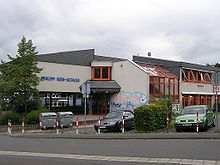
In the direct vicinity of the Peter Härtling School on Hohen Weg was the Philipp Reis School, which was built in 1969 ( comprehensive school with upper secondary school ), which around 1,600 students attend every year. The school was rebuilt as an all-day school with a cafeteria between Schäferborn and Spießwald and moved into in January 2012.
From 2004 to 2015, the Rhein-Main International Montessori School (RIMS), a private school with a children's house , elementary school and grammar school, existed in Hugenottenstrasse . The RIMS was expanded and expanded between 2006 and 2007.
Friedrichsdorf is also the seat of the Hessian Landvolk University. This educational institution was established in 1949 as a central educational institution for agriculture and the residents of rural areas.
Residents
(Unless otherwise stated, by December 31st)
| year | Residents |
|---|---|
| 1987 (May 25) | 22,336 |
| 1998 | 24,404 |
| 1999 | 24,128 |
| 2000 | 24,282 |
| 2001 | 24,406 |
| 2002 | 24,572 |
| 2003 | 24,497 |
| 2004 | 24,605 |
| 2006 (June 30th) | 24,522 |
| 2007 | 24,330 |
| 2010 | 24,875 |
| 2018 | 25.194 |
Personalities


sons and daughters of the town
- Cliff Allister (* 1957), pseudonym of Harald Hess , writer
- Marie Blanc (1833–1881), co-founder of the Monte Carlo Casino
- Paul Cérésole (1832–1905), Swiss politician
- Édouard Desor (1811–1882), geologist and politician
- Lydia Driesch-Foucar (1895–1980), artist
- Karl Willy Wagner (1883–1953) made significant contributions to the theory of electrical filters
- Abraham Louis Wallon (1807–1889), Methodist preacher in Germany and America
Personalities who have worked on site
- Rudolf Braas , head of the Taunus-Quarzit-Werke (1931–1941) and founder of the Braas-Dachstein-Werke (1953, today the Braas Monier Building Group )
- Jürgen Herrlein (* 1962), lawyer
- Philipp Reis (1834–1874), the teacher and inventor from Gelnhausen, designed the telephone in Friedrichsdorf (1861)
- Karl-Herbert Scheer (1928–1991), writer and “father” of Perry Rhodan
- Dagmar Scherf (* 1942), writer and journalist
- Martin "Maddin" Schneider (* 1964), comedian and actor, who often mentions his hometown Burgholzhausen during performances
- Emil Sioli (1852–1922), psychiatrist and founder of the Köppern Forest Hospital (1901)
- Tony (1875–1954) and Bruno Werntgen (1893–1913), aviation pioneers, founders of the German Aviation Institute in Köppern (1909)
literature
- Uschi Flacke : The witch children from Seulberg . Carlsen, 2003, ISBN 3-551-35250-X (historical youth novel about the witch hunt in today's Seulberg district).
- Angelika Baeumerth: 300 years of Friedrichsdorf (1687–1987) . From the history of the Huguenot city on the Taunus. Ed .: Magistrate of the City of Friedrichsdorf. Friedrichsdorf 1987.
- Auguste Descamps: Friedrichsdorf Taunus, Un village français en Allemagne. Draeger, ca.1900.
- Literature about Friedrichsdorf in the Hessian Bibliography
- Literature from and about Friedrichsdorf in the catalog of the German National Library
Web links
- Website of the city of Friedrichsdorf
- Friedrichsdorf, Hochtaunuskreis. Historical local dictionary for Hessen. In: Landesgeschichtliches Informationssystem Hessen (LAGIS).
- Link catalog on Friedrichsdorf at curlie.org (formerly DMOZ )
Individual evidence
- ↑ Hessian State Statistical Office: Population status on December 31, 2019 (districts and urban districts as well as municipalities, population figures based on the 2011 census) ( help ).
- ↑ Law on the reorganization of the Obertaunus district and the district of Usingen (GVBl. II 330-18) of July 11, 1972 . In: The Hessian Minister of the Interior (ed.): Law and Ordinance Gazette for the State of Hesse . 1972 No. 17 , p. 227 , §§ 9 and 13 ( online at the information system of the Hessian state parliament [PDF; 1,2 MB ]).
- ^ Main statute of the city of Friedrichsdorf in the Hochtaunus district. ( Memento of March 24, 2013 in the Internet Archive ) (PDF; 105 kB) (Basis: Section 6 of the Hessian Municipal Code (HGO) of March 7, 2005 (GVBl. I p. 142), last amended by the law of December 16 2011.)
- ↑ Ulrich Brandl, Emmi Federhofer: Sound + Technology. Roman bricks. (= Writings of the Limes Museum Aalen. No. 61). Theiss, Stuttgart 2010, ISBN 978-3-8062-2403-0
- ↑ Your Highness are back. In: Taunus newspaper. December 21, 2012.
- ^ Result of the municipal election on March 6, 2016. Hessian State Statistical Office, accessed in April 2016 .
- ↑ Hessian State Statistical Office: Results of the municipal elections of 2011 and 2006
- ↑ Hessian Statistical Office: Results of the municipal elections of 2001 and 1997
- ^ Karl Ernst Demandt , Otto Renkhoff : Hessisches Ortswappenbuch. C. A. Starke Verlag, Glücksburg / Ostsee 1956, p. 190.
- ↑ Description of the coat of arms on www.stadtrally.de
- ↑ Church leader Hochtaunus ( Online p. 22/23. ( Memento of the original from September 24, 2015 in the Internet Archive ) Info: The archive link has been inserted automatically and has not yet been checked. Please check the original and archive link according to the instructions and then remove this notice. ; PDF; 4.8 MB)
- ↑ Christel Wösner-Rafael: From the "arrest bar" to the cathedral. In: Taunus newspaper. April 23, 2011, p. 19.
- ^ Evangelical Methodist KG Friedrichsdorf (archive version from February 28, 2013)
- ^ Evangelische KG Köppern → our community → history of the church
- ↑ Evangelical Lutheran KG Seulberg (archive version from August 20, 2016)
- ^ History of the Protestant parish Burgholzhausen
- ^ Church leader Hochtaunus, pp. 24/25.
- ↑ Sacred Heart of Jesus: Demolished in January. ( Memento of the original from December 19, 2016 in the Internet Archive ) Info: The archive link was inserted automatically and has not yet been checked. Please check the original and archive link according to the instructions and then remove this notice. In: Taunus newspaper. December 19, 2012.
- ↑ alemannia-judaica.de: Jüdische Geschichte in Seulberg and Köppern , accessed on November 11, 2013 as well as the Jewish cemetery Seulberg ibid
- ↑ kinokoeppern.de → History
- ^ Structural data of the city of Friedrichsdorf. Retrieved April 25, 2014.
- ↑ Milupa relocates research to Utrecht. In: Taunus newspaper. March 12, 2010.
- ^ Report of the Taunus newspaper from February 23, 2008 and news entry on the city's website
- ↑ Loose stones in Lindenstrasse. In: Taunus newspaper. February 26, 2008.
- ↑ Roman remains are expensive. In: Taunus newspaper. November 8, 2008.
- ↑ 16.1 million for road construction in Friedrichsdorf. In: Taunus newspaper. December 3, 2008.
- ↑ Online tender
- ↑ Die Entlastungsstraße on friedrichsdorf.de ( Memento of the original from March 6, 2011 in the Internet Archive ) Info: The archive link was inserted automatically and has not yet been checked. Please check the original and archive link according to the instructions and then remove this notice.
- ↑ Unanimously for the Taunus-Carré. In: Taunus newspaper. March 18, 2010.
- ↑ stadt25-friedrichsdorf.de
- ^ Taunus-Zeitung, 2016: Ökosiedlung in Friedrichsdorf




